 |
By Susan Lyman, Historian
to The Norwood Historical Association & Museum
|
 |
By Susan Lyman, Historian
to The Norwood Historical Association & Museum
|
Preface
A young Yankee Lawyer, Benjamin G. Baldwin, practicing his profession in Potsdam while periodically purchasing land in the sparsely settled area a few miles to the North, a handful of capitalists with 'railroad fever' and a few sturdy pioneer farmers can be credited with the establishment of Racquetteville and the bringing of the Northern Railroad in 1850. Some of these people lived to see the little hamlet become the Incorporated Village of Potsdam Junction in 1872 and perhaps some even voted in 1875 to change the community's name to 'Norwood.'
Benjamin G. Baldwin, a native of Vermont and a descendant of New Englanders with a penchant for establishing new hamlets, was an 1827 graduate of Dartmouth College. After reading law with a downstate attorney, he came to the Potsdam office of Horace Allen, a widely known lawyer; eventually he was to become Mr. Allen's partner.
Mr. Baldwin began his land purchases as early as 1836, and by 1841 his final purchase brought his total real estate holdings to 400 acres of fertile farm land. He set aside a portion of this land for his own farm, a village green, and a school lot, and divided most of the remaining land into building lots to be sold to the settlers who came into the Hamlet of Racquetteville he was establishing.
|
Benjamin G. Baldwin is considered with James Symonds and Charles McCarty, as being the owners of all lands which now comprise the village of Norwood. Mr. Baldwin named the hamlet 'Racquetteville', gave 15 acres of land and access for right of way through his farmlands to the Northern Railroad. |
 |
As an inducement for the Northern Railroad to run their road through his hamlet, Mr. Baldwin gave 15 acres for a depot and such other buildings as might be required for the railroad use as well as the right of way over his farm provided the railroad was built within three years.
While the city financiers were interested in the railroads for speculative reasons, the rank and file of the residents considered it an economic necessity. The steady and increasing trek of settlers into the central and northern parts of New York State following the Revolutionary War meant a rich and isolated farm belt which lacked means of transporting produce to market. There was a more serious lack of transportation before the building of the military turnpikes which linked Sackets Harbor, Ogdensburg, and Plattsburgh. Heavy freight wagons required more than a week to make a round trip between Ogdensburg and Plattsburgh, and it was a hard two-day journey by a fast stagecoach. Canals and waterways could not be relied upon because of the rigorous climate which prevented their use for several winter months. The ideal solution was a railroad to link Boston with Ogdensburg, a busy St. Lawrence River port with ready access to the Great Lakes shipping and western buyers and producers.
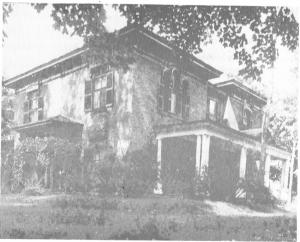
This is Baldwin Heights
This booklet is a short and very incomplete story of that link, deliberately incomplete because of the frequent changes in the railroad situation and the complexity of the subject.
North Country history books, a multitude of news clippings and the memories of 'old timer' railroad men have provided the author with the material used in the succeeding pages. Every attempt has ben made to avoid errors, and it is sincerely hoped that three years of research has made for an accurate thesis.
All typing was done on a volunteer basis by Mary Seeley, pictures are from the files of the Norwood Museum.
The first action taken toward the construction of a railroad to link Port Kent on Lake Champlain with Ogdensburg on the St. Lawrence River and the gateway to the Great Lakes came as early as 1830, according to the late Watson Berry, North Country columnist and historian, who said that James Hayward, eminent engineer, was hired to ascertain the feasibility of constructing such a railroad. In his report submitted January 1, 1831, Mr. Hayward described the three types of railroad beds and tracks: The wood and iron, the stone and iron, and the iron railway consisting of wrought iron resting on cast iron "chairs' at distances of about three feet. He favored the stone and rail construction consisting of an iron rail resting upon a continuous line of granite blocks of suitable size and length supported by a rubble wall and secured from lateral motion by embedding them in stone and gravel. This is the type of structure recommended a few years later for several New England railroads. Spruce, cedar, and tamarack were the only woods used, according to Mr. Berry.
A group of railroad enthusiasts met in Montpelier in February, 1830, and during the course of this decisive gathering a statement was made that it would be possible to travel from Boston to Odgensburg in 35 hours, this at a time when the railroad was in its infancy with only about 23 miles of railroad in the United States.
The Northern Railroad was officially incorporated May 14, 1845, and capitalized at $2,000,000 in shares of $50 par. The New York State legislature authorized S. C. Wead of Malone, Joseph Barnes and David Judson of Ogdensubrg to distribute stock. A delegation visited Boston to induce capitalists to invest in the railroad, and a phamplet setting forth the advantages of a railroad was published by James G. Hopkins of Ogdensbrug.
In June of that same year, an organizational meeting was held at Ogdensburg, and George Parish of that city was named president. He was to step, down a few months later to be succeeded by Boston financier T.P. Chandler. S. S. Walley was elected the first treasurer; James G. Hopkins, secretary; and Col. Charles L. Schiatter, chief engineer-superintendent. The Board of Directors included J. Leslie Russell of Canton; Charles Paine, Northfield, Vermont; Hiram Horton, Malone; S.F. Belknap, Windsor, Vermont; J. Wile Edmonds, Boston; Benjamin Reed, Boston; Anthony C. Brown, Ogdensburg; Isaac Spaulding, Nashua, New Hampshire; Lawrence Myers, Plattsburgh; Abbot Lawrence, Boston; T. P. Chandler and S. S. Lewis of Boston.
Following the organization of the company contentions as to the exact route followed, James Hayward made the complete surveys and Colonel Schiatter prepared to build the pioneer railroad.
Boston capitalists were looking for the easiest and cheapest way to run the railroad line and so followed the engineer's recommendations that the rails be laid from Rouses Point on Lake Champlaim along the fairly level terrain to Malone, Stockholm, through the newly created hamlet of Racquetteville, Madrid, Lisbon, and on to Ogdensburg instead of the proposed route which went from Port Kent to Hopkinton, Parishville, Potsdam, Canton to the Ogdensburg terminal. At the time it was said that Racquetteville founder Benjamin G. Baldwin's generous gift of 15 acres of land for depot and buildings as well as a right of way over his farmland led to the decision of the railroad route, but cooler heads realized that the projected route was the better one since it did not have mountain grades which would have plagued the builders had they chosen the alternate route.
The Norwood Museum has the original indenture made by Mr. Baldwin on December 15, 1845, making this gift of land.
Watson Berry had access to Engineer Hayward's official reports to the railroad committee which outlines in great detail the assets and liabilities of each route and leaves no doubt that the final decision was right although at the time, a far from popular one with the residents of the busy villages of Hopkinton, Potsdam, and Canton who felt slighted and injured. Silas Wright of Canton had agreed to attend a meeting of the directors of the road in Albany to plan the route but died suddenly only a few days prior to the meeting, leaving no one to fight for Canton and Potsdam.
According to a legend frequently told, George Parish was so disturbed that the railroad of which he was president did not run through the village of Parishville that he soon resigned his office. It was said that Mr. Parish never rode the Northern Railroad but continued to use a horse and carriage for his trips to Plattsburgh. His successor, T.P. Chandler, got the project underway.
Actual construction began during March, 1848, in a deep cut at Mile Point, just east of Ogdensburg while at Rouses Point grading and laying of rails began at the foot of Lake Champlain.
Everything did not run smoothly according to early newspaper reports which tells of a short-lived strike for higher wages. There was a controversy over the location of the shop in Malone instead of Ogdensburg, and the citizens of that city held a protest meeting to induce the constructors to extend the railroad to the harbor in the mouth of the Oswegatchie River.
A covered depot was built at Malone by W.A. Wheeler who later became Vice President of the United States.
Col. Schiatter's men worked rapidly raising the grade, while others spiked down the hemlock ties as fast as the graders worked. By fall a little 4-4-0, the 'Chateaugay,' a single benched car, was making a regular 16-mile run between Rouses Point and Centreville. The following year it was able to go as far as Ellenburg, over the newly laid iron rails.
By June, 1850, the lines had been extended as far as Malone to the east, and a short time later rails laid from the east end of the line were joined with those laid from the west.
The cost of the construction including equipment amounted to $5,022,121.31.
On September 20, the dream of linking the New England States and Atlantic seaports with the mid-west through the Northern Railroad became a reality. The little "Chateaugay" engine hauling bright yellow coaches rocked over the new line to Racquetteville (called Potsdam Depot by the railroad) to a whistle blowing, toast drinking celebration at the western terminal, Ogdensburg. John Schairer was the proud engineer who rolled his little train to a stop at the new brick Ogdensburg station after covering the 118 mile run. There was no telegraph, but the train's progress was announced by bonfires all along its route. The telegraph line was set up the following year.
The railroad officers and dignitaries aboard the "Chateaugay" were greeted be a huge croud from Ogdensburg and surrounding towns.
The History of the City of Ogdensburg by the late Rev. P.S. Garand gives this graphic account of that historic day: 'As the train pulled into the depot yard, flags were waved, shouts of joy went out from thousands of mouths, ringing of city bells were heard, bands played and cannon was fired. A procession was formed and walked through the principle streets with music and waving banners. A supper was served, free to all who desired it. In the evening speeches were made and congratulations extended during a fine display of fireworks. This was truly a gala day for Odgensburg and vicinity.'
It was said that the opening of the Northern Railroad, connecting with others reaching Boston, the Eastern towns and seaboard, was of greater benefit to this section of Northern New York than all other improvements made before 1850 or for many years later. Property advanced in value from 100 to 500 percent, and the barter system of exchange and purchase gave way to a cash system because, for the first time, the farmer had a ready cash market for his produce.
Unfortunately the railroad, the fourth longest in New York State, did not share in the wave of prosperity it brought to the North Country; rather it was plagued with financial problems so that the second track planned by the ambitious directors never materialized.
The Northern Railroad had 20 wood burning engines--it was 1879 before coal burning engines were used on this line--14 first class cars, 10 second class, 14 office and baggage cars, 237 coal and iron ore cars, 164 platform cars, 188 gravel cars, 14 iron and material cars, and 2 'large size' snow plows, buildings and facilities at Ogdensburg which consisted of docks,piers and ship terminals, freight and passenger stations and a grain elevator while at Rouses Point a wharf and pier which became part of a bridge spanning Lake Champlain were among the assets. Stations were operated at Lisbon, Madrid, Potsdam (actually Potsdam Depot, now Norwood), Stockholm, Lawrence, Moira, Bangor,, Champlain, Hayle's Landing, Brush Mills, now Brushton, Chateaugay, Rouses Point. Within a short time stations were operated at Knapps Station, Burke, Malone and other places.
The Northern Railroad became a pioneer in shipping when on July 1, 1851, the first refrigerator car in the world carried 8 tons of fresh butter from Northern New York farms to the Boston market and netted the producers an extra $900 over what they had customarily received. For years the famous 'butter train' left Ogdensburg each Monday and reached Boston on Wed- nesday morning.
This refrigerator car, considered the brain-child of Jonas Wilder, had been built in the Ogdensburg shop. Mr. Wilder used an ordinary box car, put in another roof, wall and floor, and filled the space between with saw dust for insulation. Eventually a total of 50 of these box cars within a box car were in use.
In addition to the butter train, the railroad operated milk, mail, passenger and freight trains.
Without a doubt the lumber mills which sprang up in the little hamlet of Racquetteville (renamed Postdam Junction in 1872 and changed to Norwood in 1875) prospered in part due to the availability of shipping by the railroad. The first gang saw mill on the Racquette River was built at Norwood in 1851 by Morgan, Rosenkrans and Adsit and was followed by paper mills, sash and door factory, box factory and even a kindling wood plant. A spur, commonly called 'Mill Branch,' is shown on early maps of the Village of Norwood as running from the Northern Railroad tracks directly to the large mill on the east side of the river. In the 1920's and early 1930's this spur was in considerable use with 'shifters' working many hours each day moving cars into or out of the mill. This Mill Branch was torn up years ago, and the LaRose Trailer Court occupies part of the area where the track ran.
The Northern Railroad, quick to take advantage of its geographical location at the lower end of the Great Lakes, organized the Northern Transportation Corporation in 1853, acquired waterfront property in Chicago with dockage and grain facilities there as well as in Ogdensburg. The Welland Canal and the Great Lakes were waterways used in transporting merchandise East and West. Freight cars were ferried across the St. Lawrence River from Ogdensburg to Prescott, Ontario, Canada, on the boat called 'Transit' and connections made with the Canadian Pacific Railroad.
|
This old established house is one of the very best in Northern New York; has every modern comfort. Seventy rods from the depot. New and commodious 'Omnibus' will convey guests to and from the House WITHOUT CHARGE, and invariably meets every train day and night. A good livery is kept in connection with hotel. Trusty porters at depot to give guests all proper information as regards trains and routes. |
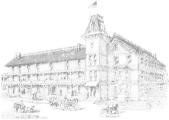 |
The famous Whitney Hotel was the stopping place of travelers from all walks of life. It was highly advertised in railroad tourist guides from which this picture was copied.
Misfortune in the nature of track problems plagued the Northern Railroad company, the right of ways washed out because of the porous earth and sand, the iron rails worn down and the hemlock ties disintegrated with the results that reorganizations were frequent.
The Northern Railroad creditors foreclosed January 1, 1858, and the new company was called the Ogdensburg Railroad. Another reorganization took place in 1864 making it the Ogdensburg & Lake Champlain (0. & L. C.) called by some 'Old and Late Coming.'
The ship operations were duly reorganized and modernized by the addition of steel vessels to the fleet, the car ferry was reorganized near the turn of the century and resulted in the Canadian Pacific Transportation Company.
Just after the close of the Civil War, many strange looking passengers began riding the train to Malone; large boxes labeled 'machinery' and billed to one Edward G. Mannix of Malone began to arrive and were loaded by the strangers.
By early summer 1866, it became certain that the Fenians were involved, and terror gripped the area.
The Fenian Society was an outgrowth of the Irish Revolutionary Brotherhood which had been formed in the 1840's for the purpose of freeing Ireland from British rule. Following the Civil War all Irishmen who had received military training in the Union Army and had not been able to find employment upon their discharge decided to attack Canada. Most of these footloose men came to DeKalb and, by way of Potsdam, rode the Northern Railroad to Malone. Several cars containing arms and Fenian officers had been intercepted at DeKalb and sent to Ogdensburg where they were imprisoned in the Seymour House, a famous old hotel in downtown Ogdensburg. In June, 1866, General George G. Meade, hero of Gettysburg, was ordered into the area with troops to dispel the Fenians. A steamer bearing two large guns patrolled the St. Lawrence River, and President Andrew Johnson issued a proclamation forbidding the transportation of the Fenians by any public carrier, General Meade dispersed the Fenian Army, arrested the leaders, and the government paid train fares for many of the 5,000 Irishmen who at last wanted to go to their homes. Many of the arms, ammunition, stores, etc., were hidden in the area or given to Fenian sympathizers while small arms estimated in value of $150,000 were taken from them by the authorities. In Malone the Fenians, 2500 of them, were encamped on the fair grounds under Col. Edward G. Mannix. They virtually took over the town, commandeering and stealing.
Even though General Meade broke up the 1866 Fenian plan for the conquest of Canada, the plot was not destroyed, only delayed. In 1870, bearded Irishmen again began to arrive in the Franklin County seat, this time going to the banks of Trout River just east of Malone. The officers, apparently loath to endure the pleasure of camp life, took up quarters in the Flanagan Hotel. General Meade was again ordered to Malone but did not arrive before the Fenian Army crossed the border to be met by a waiting Canadian militia. After firing one volley at the defenders, officers and Fenians beat a hasty retreat, an event described by historians as the greatest marathon running in the North Country's history. Local residents gathered up the discarded rifles and the Northern Railroad did a land-office business transporting the Fenians and troops to south-bound connections. Business was so brisk that special trains were put on to accommodate the overflow.
In 1870 the Vermont Central Railroad leased the 0. & L. C., giving the leasee a long hoped for Great Lakes ocean transportation system. The line prospered for some years, and the White Mountain Express thundered over a portion of the tracks with its fancy sleeping and parlor cars. A breakfast stop was scheduled in Norwood, and passengers would leave the cars at 6:30 a.m. to eat if they wished while the train crew changed for the run into Rouses Point.
During the prosperous period, 1887-1892, the line increased its engines from 28 to 34, some of them heavy duty engines, to handle the huge traffic. But railroad politics played havoc with the little railroad. Business dwindled and in 1898 a decree of foreclosure and sale was issued. The 0. & L. C. was again adrift on the wild sea of high finance as was the Rutland Railroad, another of the Vermont Central's roads. In 1901 the Ogdensburg line signed the papers with the Rutland's president. Locomotives and rolling stock were in such poor condition that some were destroyed as unsafe. Grain shipments became so small that the frame grain elevator at Norwood was torn down. However, the car repair shops and various other buildings made the Norwood railroad yard a busy place and the crossroads of Northern New York as the terminal for three railroad lines.
In 1902, Mr. William S. Webb, a politically ambitious dentist and son-in-law of William W. Vanderbilt, became president of the Rutland Railroad with a board of directors consisting of such millionaires as Chauncy Depew, J. P. Morgan, William Rockefeller, William K. and Frederick W. Vanderbilt. The policies of the New York Central Railroad were said to predominate the Rutland Railroad through the influence of Webb who, in 1905, became president of both roads, and the controlling interest in the Rutland was obtained by the New York Central and Hudson River Railroads.
When automobile traffic began to increase, a flagman was stationed in a little building on Norwood's Main Street just north of the present day restaurant. John Robinson, a veteran railroad man, for years stopped the road traffic in order that a train could pass over the crossing. Later James A. (Alva) Henry, Keith Edwards, and possibly others performed this duty.
At the beginning of World War 1, the Rutland Railroad, like all American railroads, was taken over by the U.S. Railroad Administration to halt threatened breakdowns. President Woodrow Wilson appointed William G. McAdoo as director with almost unlimited power over the railroads. When the railroads were turned back to the owners in 1920 they were practically wrecked; only the most urgent maintenance had been done to keep the stock rolling.
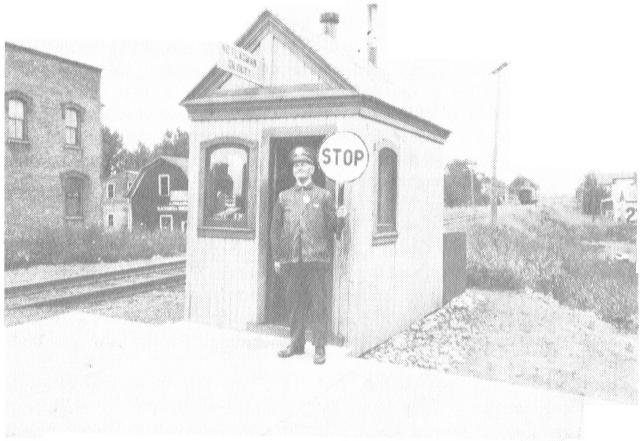 |
The Panama Canal Act of 1915 had been a serious blow to the Rutland Railroad. The law mandated the disposal of its connections with shipping, and all of the Ogdensburg-Chicago ships had to be sold. The little railroad line then watched the New York Central take over the grain cargo traffic it needed to survive. This left the Rutland with only dairy products and some grain to transport in the years that followed and until the beginning of the motorized trucking fleets and the post-war boom which lasted only too briefly for the railroad.
An agreement with the Canadian National Railway in 1929 enabled the Rutland to connect with that road at Rouses Point, making 407 miles of track and bringing the total of men and women employees to 1100.
Financial woes, organization, and reorganization continued from time to time. By 1938 the Rutland was operating on a day to day basis and in real danger of abandonment. Receiver George L. R. French asked the U.S. District Court for permission to abandon the road if a buyer could not be found. The Rutland Railroad Cooperating Traffic Association was formed in 1938 and raised about $11,000 to hire a traffic expert to develop more sources of income.
Tax abatements were granted the dying railroad by the States of Vermont and New York, and a fast train to move traffic from Boston to Norwood and on to Western points with attractive rates and scheduled was proposed. Thus the famous 'Whippet' came into being. Old No. 28, a 2-8-0 of 1913 vintage was taken off the line, painted a gleaming black, and embellished with metal skirting, silver trim, and her name, 'Whippet' on the tank. She began her career on January 9, 1939. Several other engines served on this fast freight line but without the dress up accorded old No. 28, although the 'Whippet' slogan was placed on much of the rolling stock of the Rutland. No. 28 lost her skirting to an early World War II scrap metal drive, and she reverted to her former simplicity. The 'Whippet' line was moderately successful because of the world situation just prior to the United States' entry into World War II. Business picked up briefly, and the employees began to seek back pay with- held for several years. Operating expenses had been mounting; deferred taxes, maintenance, and other expenses were looming in the offing and had to be honored or there would be no railroad. The Railroad had been paying their employees as much as they had been receiving, and talk of cutting pay brought a firm refusal from the unions. The first strike vote in the history of the railroad was taken, but the railroad was saved once again by President Franklin D. Roosevelt voiding the embargo notices announcing the shutdown of the Rutland.
In 1943 preferred stockholders filed a petition in the United States District Court to be allowed to reorganize the company only to be refused; but the next year the Court of Appeals reversed the decision, and the Rutland was permitted to reorganize. Other actions caused the case to be referred to the Bankruptcy Court for reorganization.
Trains #6 and #3 were discontinued in 1949, and a new star route was instituted to convey mail between Ogdensburg and Norwood.The Rutland Railroad became a thing of the past November 1, 1950, when the Rutland Railway was born.
Knapps Station, a caretaker station since 1932, was closed in 1951, torn down and the lumber used to build a house in Norwood. Railroad records show that, during 1950, the revenue from Knapps was $49.31, operating expenses, $565.20. The previous year the income had been $89.20, expenses, $576.19. The Rutland reported on May 31, 1951, that their working capital was only $304,000 and the men were working for sub-standard wages.
A three-week strike hit the railroad in 1953, and passenger service was discontinued. A strike was experienced in 1960, and on September 25, 1961, the freight service struck and the last Rutland train ran.
Abandonment hearings were held in Vermont and Malone early in 1962, when the Interstate Commerce Commission approved the application for abandonment effective early in 1963. Railway labor factions sought court injunctions to block this move, and a four-month reprieve was given the State of Vermont time to find a buyer. The legislature of Vermont passed a bill allowing the state to purchase a part of the Rutland for lease to operators, and late in 1963 the Rutland Railway Company was free to dispose of its property as it saw fit. The road had been idle for two years.
While the Rutland Railway was coming to grief in Vermont, Nelson Rockfeller, Governor of the State of New York, announced the extensive port development at Ogdensburg and an advance of $50,000 to secure title to the Rutland property, with preliminary state approval for purchase of the railroad facilities for the price of $765,000.
In 1964 the Ogdensburg Bridge and Port Authority applied to the Area Redevelopment Administration (ARA) for a loan of $2,267,610 for improvement to the Ogdensburg port and the purchase of the railroad line from Ogdensburg to Norwood with the warehouse and grain elevators in Ogdensburg.
W. 1. Ginsberg, Rutland Railway president, said a firm commitment to
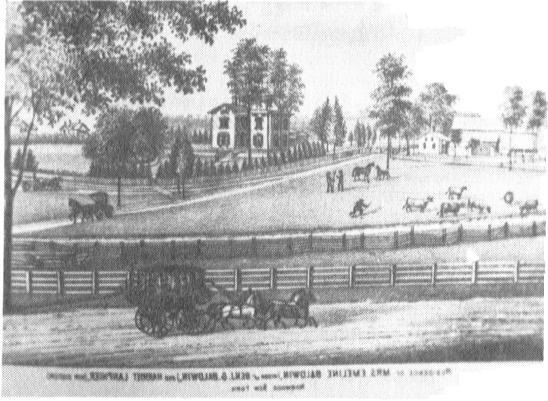
purchase from Norwood to Vermont state boundary must be effected by August 31, 1964, or 'salvage operations will promptly begin.' The tracks were torn up east of Norwood and sold to L.B. Foster, New York City, as junk.
In 1965 another loan of $275,000 was made to the Ogdensburg Bridge and Port Authority to complete payment to the Rutland for terminal facilities, grain elevators, and trackage from Ogdensburg to Norwood, the eastern terminal. The federal government announced an advance of $410,000 of which $350,000 should apply on the purchase price with the balance to be used to refurbish the railroad facilities.
The Interstate Commerce Commission authorized the Ogdensburg-Norwood Railway, August 15, 1967; and only three months later, November 15, 1967, the line officially began operations of the 25-mile line which extends easternly from the'Ogdensburg railroad yards to Norwood where it connects with the Penn Central. The rail line was leased to Herbert Heidt of Middletown, New York, a veteran employee of the Ontario & Western Railroad and the East Coast Railroad Company.
The main commodity hauled at the beginning was coal for the St. Lawrence State Hospital, powdered whey from a dairy storage facility, and feed for local dealers.
The St. Regis Paper Company, operators of the Norwood & St. Lawrence Railroad, considered abandonment of that short line in 1973. The Bridge and Port Authority again came into the news when Executive Director Jaynes McGuiness was authorized to seek some solution and method by which the Simplicity Pattern Company of Norfolk could continue to have rail service and develop their operations further. It was estimated that the operation of the additional trackage would cost $15,000 annually to service the mill and a lighter engine would be required.
The Northern Railroad which opened with such fanfare in 1850, became the Ogdensburg & Lake Champlain during one reorganization, later the Rutland Railroad. The line served the North Country for 110 years in diverse ways. It transported produce to distant markets, brought in merchandise to stock stores with the most desirable goods from the cities and other parts of the world, provided passenger service, carried the sick and wounded to receive medical treatment at the Ogdensburg hospital. Many times a baggage car was an improvised ambulance. Men of national acclaim rode over the 118 miles of gleaming track as did the men and material for America's wars.
Perhaps the proudest moment of all came when the Tomb of the Unknown Soldier was transported on a flatcar part of the way to its final resting place in the Nation's Capitol.
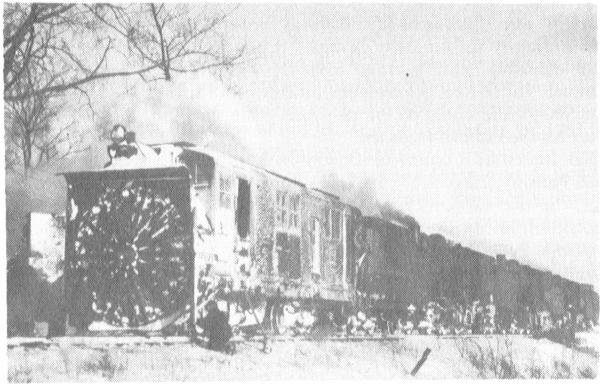 |
Snow removal in the early days of railroad operations was done with a rotary plow plus three whale engines (cut No. 1) or the traditional method of men with shovels (No. 2).
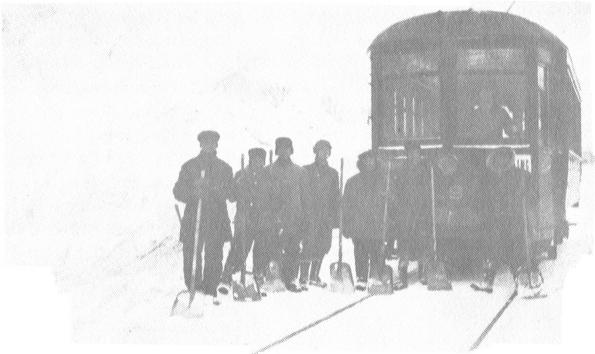 |
'Announcing ConRail, a better way to run a railroad,' read the banner headlines of a full-page advertisement in an April, 1976, issue of a North Country daily newspaper. ConRail was given life in Philadelphia, Pa., on April 1, 1976.
It was off with the old struggling, bankrupt Penn Central and on with the new Consolidated Rail Corporation (ConRail), a giant consolidation involving the Penn Central, Lehigh Valley, Central of New Jersey, Reading, Lehigh & Hudson, and the Erie Lackawanna Railroads creating 17,000 miles of track in 16 states.
Thus came the end of a railroad which since the early 19th century had been an important part of the North Country story.
Railroad fever struck Watertown early, a mere three years after the first iron horse had been introduced into this country. Civic minded citizens obtained a charter for the proposed Watertown-Rome (W-R) railroad in 1832. The city of Utica had staged a strong campaign to be selected as the site of the chief terminal but lost out to Rome. Orville Hungerford of Watertown was elected the first president of the W-R which was incorporated April 17, 1832 and commissioners were named by the State Legislature, capital stock was fixed at $1,000,000 divided into shares of $100.
The Railroad Act provided that the railroad should be begun within three years and completed within five years. The survey was completed in 1836; the Act was not allowed to expire in 1837, 1845, or 1847 because it was 16 years before construction actually began.
Two Watertwon men, William Smith and Clarke Rice, worked diligently to keep the road alive by riding the proposed route on horseback with a model train for demonstration purposes. Smith was paid $2 per day to solicit subscriptions, and the sum of $500 was set up as a fund to pay the expenses of Hungerford and the Directors to go to New York City and Boston for the same purpose.
The original Railroad Act for the construction of the line was extended to April 28, 1847, and allowed for an increase of capitalization from $ 1,000,000 to $1,500,000 in order that the new road could be properly equipped with iron rails.
The actual work was begun in 1849 and thought was given to extending the line northwestward to Cape Vincent on the St. Lawrence River.
Despite the director's complaints that a large number of the stockholders were farmers not in possession of much ready cash, the entire 72 miles of road was open from Rome to Watertown in 1851 with the completion of the Cape Vincent line the next spring.
The railroad was prosperous, paying a 10 percent dividend, and inciting others in the northern area to action.
The spirited citizens of Potsdam organized the Potsdam Railroad Company in 1850, with Joseph H. Sanford, William W. Goulding, Samuel Partidge, Henry L. Knowles, Augustus Fling, Theodore Clark, Charles T. Boswell, Willard M. Hitchcock, William A. Dart, Aaron T. Hopkins, Charles Cox.
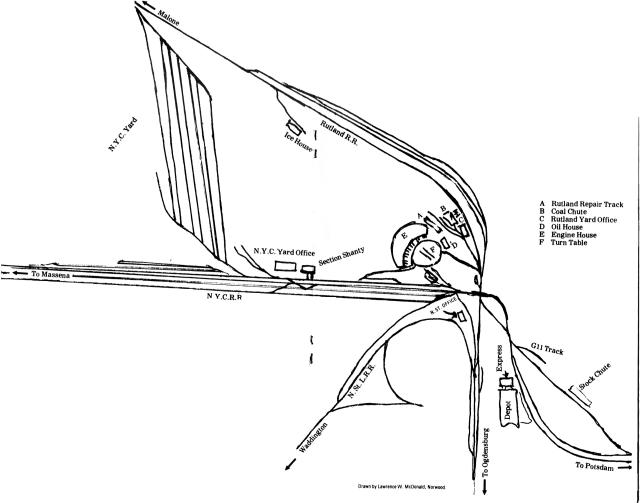
Nathan Parmeter, Horace Allen, and Liberty Knowles as directors and early stockholders.
Soon after incorporation a five and one half mile line was built to connect with Racquetteville (Norwood) and the Northern Railroad. The line opened in 1856.
The consequent prosperity stirred interest in Canton, Gouverneur, and other towns and led to demands that the line be extended from Potsdam to Watertown. Money was scarce. St. Lawrence Couhty was poor and underdeveloped in those days, but a college was being built at Canton and Academies at Potsdam and Gouverneur.
The Potsdam & Watertown Railroad Company was organized at a meeting held at Gouverneur and directors elected. By 1853, $750,000 had been raised and capital stock was increased to two million dollars, and it is said that some of the directors had to pay their own money for locomotives and two cars, receiving repayments in installments.
The road was built in sections from Watertown, first to Evans Mills then Philadelphia, Gouverneur. When the Rome section was 24 miles north of that city, service ran to Camden with fares set at three cents a mile and later a second class was instituted with rates at half that amount.
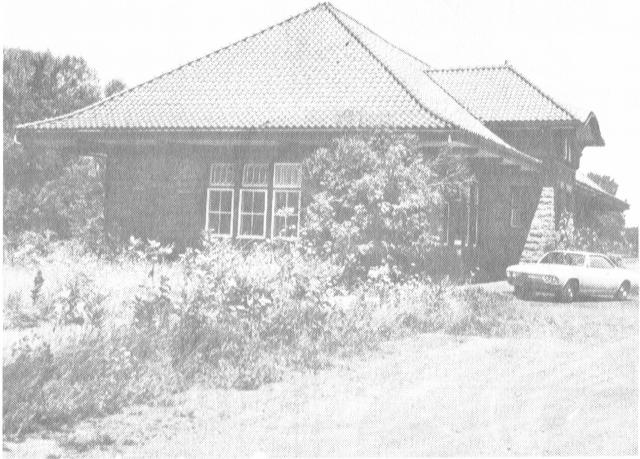
Potsdam's depot was one of the most elaborate in the North Country. This building, erected in about 1914 replaced the earlier depot which is said to have been located nearer the Racquette River. It was closed some years ago and is presently the site of a restaurant.
Four second-hand engines were bought in New England, and negotiations were completed with the Taunton Locomotive Works for engines at a cost of $7150 each. Horace W. Woodruff of Watertown was given the contract for building cars with his pay to be one-third in company stock and the balance in cash.
The finished cars were hauled to the tracks by teams of oxen.
The first engines were the Lion, an 8-wheeled, 14-ton engine which eventually blew up, the Roxbury, Commodore, and the Chicopee. Other famous locomotives include the Orville Hungerford, a 21 1/2 ton machine, the Watertown, the Rome, Adarns, Kingston, a 22 1/2 tonner, all built by William Fairbanks of Taunton, Mass. These were wood burners, coal and diesel oil came much later.
The year 1851 was a great one for the railroad company for in May of that year the train came to Pierrepont Manor in Jefferson County, and on September 24, the first locomotive came into Watertown where a great celebration, parade, and 72-gun salvo accented the occasion. Promptly at 9 a.m. February 5, 1857, a passenger train left Watertown and passed over the entire line to junction with the Northern Railroad at Racquetteville (Norwood),

The four McCormick men worked a total 211 years for the railroad. Show L. to R: Lawrence, 98 when this picture was made, was believed to be the oldest pensioner in the system, began work on the R.W. & 0. at the age of 15 and retired in 1921 as an engineer with 55 years of service; John, 84, a brother, started on the R.W. & O.; Cornelius (Con), 80 began railroading in IM and retired as an engineer and Frank, 74, son of Lawrence, began his career in 1891 and retired in 1943 after 53 years.
establishing a definite passenger service.
Financial woes pursued the Potsdam-Watertown Railroad, and in June, 1860, the Watertown & Rome gained financial control to form the Rome, Watertown & Ogdensburg (R W & 0) Railroad. They followed moderm business practices by the use of telegraphic orders, and one of the early operators at Norwood was Omar Hine. They instituted fast passenger service, sleeping cars, and an elaborate system of 'excursions.'
A director's report for 1864 claims a 25 percent population increase in St. Lawrence County during the preceding ten years. The next decade may not have been so good for an 1874 newsclipping states that the pay of laborers of the R. W. & 0. had been reduced to one dollar per day.
By 1894 the R. W. & 0. was offering a series of summer tours to the Maine seacoast in a publication which contained more that 600 extended summer tours, stating that the "gratuitous revised and enlarged edition, available for 10 cents postage was to furnish patrons with a complete list of routes and summer tours and rates and places to go in the north and east.' The well illustrated booklet describes Norwood as the junction point with the Ogdensburg & Lake Champlain Railroad which forms, with the R. W. & 0. and their connections, the Niagara Falls, White Mountain, Portland & Bar Harbor line, over which sleeping cars run between Portland and Chicago connecting directly to and from all points west. Connections were made at
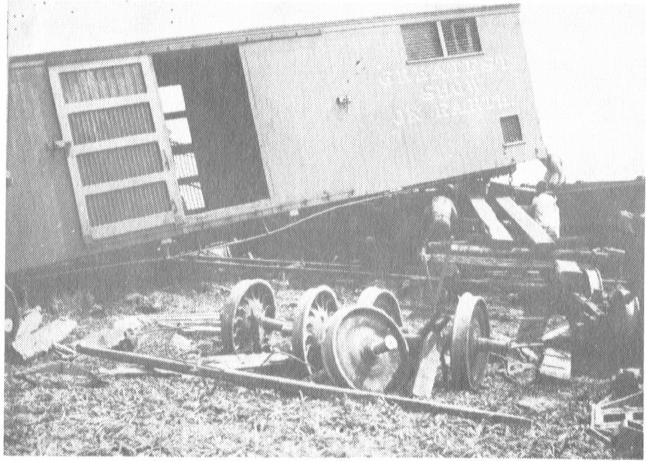
One of the most famous mishaps on the local railroads was the wreck of the Barnum & Bailey, "Greatest Show on Earth" Special train in the late IBM'S. The accident occured at Clark's Crossing on present day Route 56 between Potsdam and Norwood. Circus animals were killed but there were no personal injuries.
the Portland Union Station for the Maritime Provinces and along the New England coast. The New York Central and Hudson River Railroad Companies were lessees.
The list of hotels and boarding houses gave two for Norwood; American Hotel, Bailey & Welch, proprietors, 40 room capacity, rate $2 daily or $7 per week, and the Whitney Hotel run by S.R. Phelps, 30 room capacity, free omnibus and rate $2 daily. Travelers were informed that stages left the R.W. & 0. Railroad station at Norwood for Norfolk, three miles, fare $.25; Raymondville, 6 miles, $.50 fare; Louisville, 11 miles, $.75 fare, and Louisville Landing, 16 1/2 miles, $1 fare. Norwood was a 'breakfast stop" at about 6 a.m. each day.
Stagecoaches were used to transport passengers between Norwood and Massena until the Massena line was opened in 1886 with the traditional parade and speeches accompanying a dinner at White's Hotel. At one time Fletcher Donaghue drove the stage owned by his uncle, Col. Uriel Orvis. Guy Bridges was another early driver as was Dennis Regan.
The 1886 report of the Railroad Commissioners states that the Norwood & Montreal Railroad filed Articles of Association March 1, 1886, to build a line of railroad from a connection with the Rome, Watertown and Ogdensburg terminal at Norwood to the Canadian border at or near Fort Covington. The line was completed to Massena Springs (12.94 miles) September 27, 1886, and leased to R. W. & 0. The Grand Truck from Montreal came there.
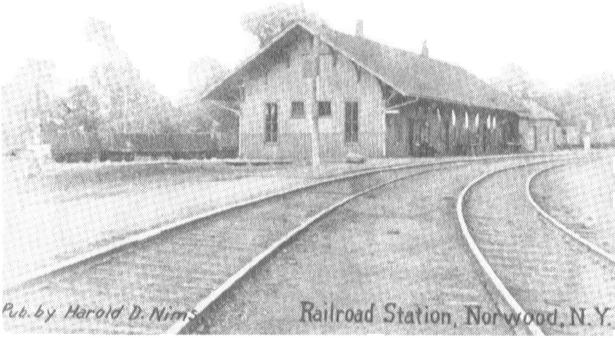
The railroad depot at Norwood stood at the eastern end of Mechanic and was the second depot in the village. The original building stood further down the tracks, was moved some distance to the west and modernized. A portion of the original depot is now incorporated in a Norwood home. The depot was torn down some years ago, but in its heyday was one of the busiest places in the village.
A confusing number of mergers, consolidations, and purchases had been in process for sometime with the net result that the R.W. & 0. was leased to the New York Central Railroad and Hudson River Railroad in 1891 to become the longest and most important summer resort tourist traffic route in American. They stressed the great expense in relaying the heaviest steel rails, renewing and reballasting roadbeds, new ties, replacing bridges with steel and iron, all to inaugurate a new era in Northern New York passenger train service. The trains had solid vestibules, new day coaches, Wagner sleeping cars, drawing room, cafe, smoking and library cars, all at no extra charge to the passenger.
Wealthy William H. Vanderbilt and his dapper son-in-law, Dr. W. Seward Webb, president of the Rutland Railroad, and of the Wagner Palace Car Company, were deeply involved in shortlines in several areas of the state. Their connection with the New York Central resulted in the purchase of all outstanding stock of the St. Lawrence & Adirondack in Canada, leased the Mohawk-Malone but later absorbed it. In 1913 the R.W. & O., the New York & Ottawa, and some other smaller roads became a corporate part of the New York Central & Hudson River.
For a number of years passenger service between Massena and Syracuse was served in part by the 'Beeliner', a one-car diesel powered unit. A passenger report on the average number of patrons served in 1961-62 were 9 on the north run and 7 on the southbound train, obviously the run was not profitable. The 'Beeliner' made its last run February 15, 1964, ending 78 years of passenger service by the New York Central Railroad in Norhtern New York.
The New York Central and Pennsylvania Railroad were merged into the Penn Central Transportation Company February 1, 1968, in order to provide a single more efficient and profitable railroad better able to serve its customers. Penn Central, in December, 1968, acquired the bankrupt rail operating properties of the New York, New Haven and Hartford Railroad

as directed by the Interstate Commerce Commission as a condition of the merger.
The follwing June, Penn Central entered reorganization under Federal Bankruptcy laws. According to Penn Central officials there were approximately 40,000 miles of tracks and 78,000 employees in its huge network.
It might be noted that Penn Central was the first common carrier in Northern New York to use the piggyback method of freight transportation to handle cargos of Canadian made General Motors automobiles from a factory near Ottawa to Farmingham, Mass., a three-day trip.
In 1974 the St. Lawrence County Fire Coordinator advised all local fire departments to plan alternate routes for fires and emergencies since all freight had been slowed to 10 miles per hour in some areas due to track repair problems. Later in the year trains were back to the normal 30 mph speed.
Even though the bankrupt Penn Central continued to operate, it was at a huge loss; but liquidation was opposed by both the Interstate Commerce Commission and the directors of Penn Central and its 160,000 stockholders. A spokesman, according to newspaper resources, estimated it would take 250 million dollars annually in government subsidies to operate the line in the black.

The R.W. & O.inspector's building in 1892. Shown are Jack McCarthy, Pat Flynn, William Smith, Mr. Holienbeek and Bert Flitt.
A 1974 traffic count for the Transportation Department recommended retaining the rail system for the Northeast, showing Norwood with a 334 carload annually. The following year there was talk of closing some short lines, and a prediction of a 3500 employee layoff in order to reduce operating expenses.
However on April 1, 1976 Penn Central was one of seven bankrupt northeast railroads to be consolidated as 'The Consolidated Rail Corporation' (ConRail) created by the United State Railway Association under the Regional Rail Reorganization Act of 1973. Reliable news accounts of the merger report that two billion dollars of government funds are involved in the new 'ConRail.'
There is no possible way of listing the names of all those thousands of individuals who were railroad employees, but at one time many Norwood residents were 'railroading', oftentimes all the male members of the family worked for a railroad system, the Fiaccos, Reagans, Regans, Donovans, McCormicks, Flynns, McCarthys, McClelland, Wilkins, Mott, Moultons, Claffeys, Purves, and others.

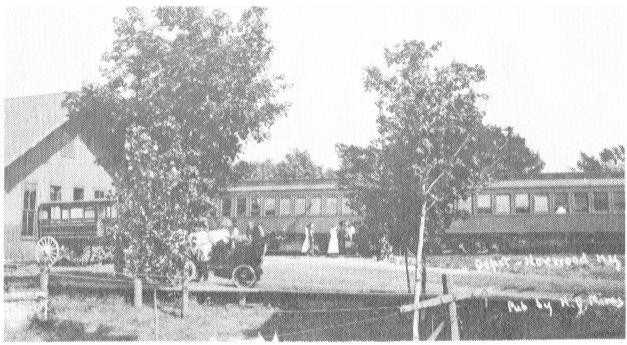

New York Central (Con Rail)
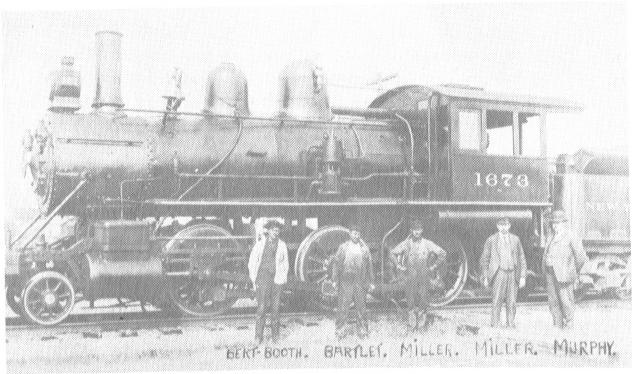
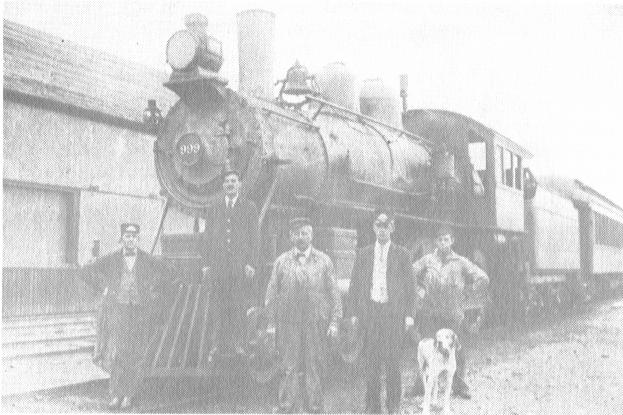
Norwood & St. Lawrence Railroad
The story of the Norwood & St. Lawrence Railroad (N. & St. L.), an 18.26 mile shortline running between Norwood and Waddington, is closely associated with the building of the Remington & Martin Paper Mill at Norfolk, for it was this construction at the turn of the century which led the people of the area to become aware of the necessity for railroad transportation.
Orrin E. Martin, a Norwood man with diverse business enterprises, interested Charles H. Remington, a Watertown industrialist, in the development of the water power in Norfolk, and this culminated in the founding of the Remington & Martin Paper Company. The firm secured water rights on the Racquette River in Norfolk as well as a right of way for a railroad.
A 'railroad meeting' attended by male residents from Norfolk, Chase mills, and Raymondville (plus four ladies who received particular notice in newspaper accounts of the gathering) was held in the Norfolk Town Hall in February 1900. 0. E. Martin was elected chairman and D. Crowely, secretary. The purpose of the meeting was to devise a plan whereby Norfolk could obtain railroad facilities for passenger, mail, and freight service. Talk at that time included ambitious plans for the construction of a railroad along the entire Racquette River from the St. Lawrence River to Piercefteld at least (sic).
Named to a committee to plan and recommend means by which the 7 built to the St. Lawrence River, were H.H. Atwater,S. Putney, and C. A. King, Norfolk; William Coates, Raymondville; Mein and Barney Nowland, Chase Mills; Burt Crasper and C. S. Plank ,Waddington.
A hundred people were on hand at 8 a.m., September 6, 1900, when E. Martin turned the first sod for the new railroad at Norfolk. The road was scheduled to commence on the north side of the river near the Furnace Street bridge and run to the mill and 'will be continued westward about one-half mile where it will be decided whether to continue to Norwood or run to connect with the R. W. & 0. at the Marble Hill School House,' said a newspaper account of the day. Dr. S. J. Putney, Rev. John Bragg, and E. H. Atwater were the speakers at the groundbreaking.
The little railroad was incorporated March 30, 1901, and later, through consolidation on January 21, 1909, became the Norwood & St. Lawrence Railroad, a busy little road serving business, manufacturing, and residents since its official opening in 1902.
The Public Service Commission Report of 1912 lists the rolling stock of the N. & St. L. as follows: locomotives, 1,2-6-0; 2,4-4-0; 1,2-6-2, plus seven box cars of 30 ton capacity; four flats of 20 ton capacity, and three company service cars.
Remington & Martin built three mills, one each at Norwood, Norfolk, and Raymondville. The Norfolk mill boasted two paper machines, one said to be the largest such machine in the world at the time. When the railroad was extended to junction at Norwood, and Waddington in 1908, the hauling of pulp became one of the important functions of the line.
St. Regis Paper Company acquired the mills and railroad in the 1920's and with the recession brought by the depression in the 1920's and early 1930's, papermaking became unprofitable and so the mills at Norwood and Raymondville ceased to operate and were eventually razed.
The closing of the Norfolk mill was a serious blow to the economic life of the Norfolk area, and in the manner of Northern New Yorkers, the business leaders and man on the street banded together to form the Development Corporation of Norfolk in 1962 for the purpose of finding a buyer for the mill. Government subsidy was secured, and the mill ran sporadically until the Simplicity Pattern Company took over the operation.
On June 2, 1973, the Norwood & St. Lawrence Railroad Company, a subsidiary of the St. Regis Paper Co. since 1920, filed application with the Interstate Commerce Commission to abandon the line of railroad from Mile Post 0 near Norwood in a northwesterly direction to the end of the line near Waddington, a distance of 18.26 miles. The railroad holdings included the station and roundhouse at Norfolk, two 70-ton diesel and electric locomotives, 24 acres of property at Waddington, plus the docking facilities.
With the general reduction in traffic and the elimination of pulpwood imports from Quebec, the number of carloads dropped from 2513 in 1971 to 161 in 1972. In 1973 the Norwood and St. Lawrence gave service to the Simplicity Pattern Co. which operates in the mill built by Remington & Martin, the Hanes & Hanson store at Waddington, and a few others. Simplicity Pattern Co. averages 8-10 cars weekly while the Waddington run included one carload of feed once a week. The paper mill at Norfolk is dependent upon railroad shipments and plans to increase production and shipping in the future.
The picture brightened for that company when the Ogdensburg Bridge and Port Authority took over the operation of the N. & St. L.
On January 2, 1975, Michael J. Walsh, Jr., vice president for transportation and distribution of the St. Regis Paper Co. and the president of the N. & St. L., donated the assets of the railroad to the Ogdensburg Port Authority and assured the continuation of rail service.
The transfer took place at the Gran View restaurant, Ogdensburg, during a meeting which involved Robert H. Wagner, Norfolk, manager of transportation of N. & St. L., Dr. David DePue, chairman of the Ogdensburg Bridge & Port Authority, Michael J. Walsh, Jr., Carl G. Premo, secretary of the Authority, George B. Looney, Tom Patterson of Canton, James P. Mc Guiness, Executive Director of the Authority, and Richard Van Duzee, Port director.
While the several shortline railroads operating in Northern NewYork did not enter the Village of Norwood, they were important in that they completed rail routes from the surrounding rural and lumbering area to the larger railroads going to far away places with commodities for market.
1.
THE NEW YORK AND ERIE - 1851 - the first railroad to span New York State from the Hudson to Lake Erie. The first run carried President Millard Fillmore, his cabinet, Daniel Webster and others. President Fillmore rode in a rocking chair lashed to a flat car so he could enjoy the scenery.
The engineer, 'Pappy' Ayres, had been a conductor at one time and is credited with the conductor-to-engineer signalling device.
OGDENSBURG, CLAYTON AND ROME RAILROAD - 1853 - one of the leaders in this railroad was Henry VanRensselaer, a large landowner in the Ogdensburg area. He was an active director of the Northern Railroad but resigned to become associated with the O.C. & R.
ADIRONDACK & ST. LAWRENCE - 1891-1892 - (Remson to Malone) became a part of the Mohawk & Malone Railroad in 1893 and was leased to the New York Central to operate its 40 or more engines as part of the Mohawk Division
THE MALONE & ST. LAWRENCE - 1892 - was built from Malone where it connected with the St. Lawrence & Adirondack and extended to Valleyfield, Quebec.
THE NEW ST. LAWRENCE & ADIRONDACK - 1896 - formed by the consolidation of the St. Lawrence&Adirondack,the Malone and St.Lawrence and the Southern Railroad. It was leased to the New York Central which purchased at least 30 locomotives.
FULTON CHAIN RAILROAD (Peg Leg Railroad) - 1889 - rails were made from split logs and operated between Port Leyden, Boonville, Moose River Settlement only during the summer session, closed 1892.
CRANBERRY LAKE RAILROAD - 1902 - ran from Benson Mines to Cranberry Lake, 6 miles, where it made connections with the Carthage and Adirondack (C&A), sold in 1914 and tracks pulled up in 1917.
GRASS RIVER RAILROAD - 1913 - carried summer residents to Cranberry Lake and connected with the New York Cent;al Adirondack Division at Childwold.
LOWVILLE & BEAVER RIVER RAILROAD - 1903 - built and operated 10 1/2 miles between Lowville and Crogan to carry dairy products, farm goods, paper products and passengers.
CARTHAGE & COPENHAGEN CO. - 1906 - Passenger service, including carrying children to and from school, also milk, cheese, cattle, coal, feed, and lumber. Dissolved in 1918-19.
ADIRONDACK & ST. LAWRENCE RAILROAD - 1908 - a shortline between Stellaville and DeKalb Junction (I mile) to carry pyrite, ore, copper, and chemicals used in paper making and gun powder during World War 1. Later extended 2 miles to Hermon. Stellaville mines closed after World War 1. During the war carried a carload of milk daily from both Heuvelton and Rensselaer Falls to the Nestle Foods plant to be made into condensed milk.
After the mines and Nestle plant closed, all rolling stock was sold in 1921 and the tracks removed in 1924-25. The company had 3 locomotives at the time of abandonment.
GRASSE RIVER RAILROAD - 1915 - a 16-mile road from Childwold to Cranberry Lake for logging and passengers. A combination passenger and baggage coach served the tourists who could arrive at Childwold on the New York Central-Montreal express. Rails taken up in 1948.
NEW YORK & OTTAWA - 'Old Kick,& Push' - the New York Central abandoned a part of this logging road in 1937 and tracks were torn up. The line had been the first into the Adirondacks to Tupper Lake, St. Regis Falls, Santa Clara, Dickinson Center, and Brandon, frontier towns. Moira was a railroad center where the N.Y. & 0. crossed the Rutland tracks. Line still runs from Helena to Ottawa.